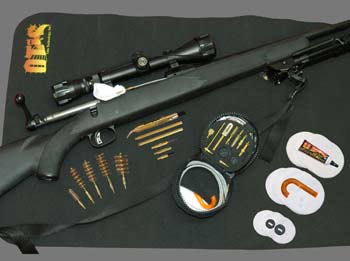Keeping Guns Looking New With Proper Cleaning
Step One: make sure the gun is unloaded.


MADISON Wi – -(AmmoLand.com)- Hunters in search of a meaningful New Year resolution might consider pledging to keep their valued firearms in tip-top shape with proper and effective cleanings twice each year of the new decade.
“The holidays are over and most of the state’s hunters are done for the season. Now is the time to clean your firearms,” says Tim Lawhern, Wisconsin Department of Natural Resources conservation warden and administrator of hunter education programs. “That means a series of steps that will ensure your firearm is ready for the next hunt or a practice shooting session.”
Lawhern says he, as is the case with many hunters, learned gun-cleaning techniques by watching others. That’s good and bad, he says.
“I have heard stories about unintended firearm damage inflicted by gun-owners who learned their methods from others who thought they were doing the right things,” he says.
Lawhern points to a series of what he calls basic maneuvers to protect your firearm investments.
“A good practice is to clean them twice per year – even if you have not fired them. This will prevent rusting and keep them in working order.”
Do not store your firearms in the cases you use for transport to and from hunting excursions.
“Those cases often hold moisture which is not your firearm’s friend for storage. You need a safe or closet you can lock.”
Before you begin, gather all the proper equipment in one place. This will help guide you through the steps without having to remember.
The equipment needed includes:
- Gun vise or cradle to support the firearm
- One-piece cleaning rod, sized to fit the firearm
- Bore guide, sized to fit the firearm
- Jag tip of proper caliber for rifles and handguns, or correct bore brush for shotguns
- Powder solvent to remove residue by burning powder
- Copper solvent to remove copper left by jacketed bullets
- Cotton patches (cotton does not melt when burned, synthetic patches react with solvents)
- Gun oil
Unload and clean the barrel
The first step is to unload the firearm.
“Don’t take anyone’s word for it. Look for yourself,” Lawhern said.
Next, always clean the barrel from the breech to muzzle when possible, he said. Place the firearm in the vise or gun cradle and install the bore guide so the cleaning rod runs down the center of the bore. Install the proper sized jag tip on the rod. For shotguns, Lawhern said, the slotted patch tip is fine.
If your firearm is equipped with a scope, make sure you leave the lens caps on or provide some sort of protection like a cloth to cover them.
“It’s important to note here the proper technique while cleaning the bore,” Lawhern said, adding all patches should go only one way down the bore. “Do not push a patch down the bore and then bring it back in. All that does is return the dirty patch along with its grit into where it came from.”
Also, he said, the motion of the rod should be one smooth stroke. Do not push a few inches in and then stop and push some more. The first patch down the bore should be a dry one to wipe out the large crud. Place newspapers on the floor or table to catch the debris as it falls.
Patches – get the right size
“If you need a jack hammer to get the patch all the way through the bore, off-center the patch by placing the jag tip halfway between the center of the patch and one corner,” Lawhern said.
But if still too tight, Lawhern says turn to a smaller patch.
Next, alternate a wet patch with powder solvent and then a dry patch down the bore. Repeat until you no longer get gray or black on the patches. After that, switch to the copper solvent.
“Read, understand and follow the manufacturer’s recommendations for copper solvent,” Lawhern said. “The vast majority of copper solvent has ammonia as a base component. Left in your bore too long and it will cause pitting. You won’t be happy if that happens. When you no longer get green or blue on your patches, you are almost done.”
For shotguns copper solvent is usually not necessary. Bore brushes may not be necessary. For rifles and handguns a bore brush is not needed, Lawhern said.
“For shotguns, a bore brush should be used to remove stubborn spots,” he said. “Bore brushes should only be nylon or bronze bristled. For the average person that takes care of their firearms properly you don’t need them.”
Next, soak a single patch with gun oil and run it down the bore, remove it from the jag tip and use that patch to wipe down the outside of your firearm. No additional oil will be needed. Remove the bore guide and clean the action, including the bolt and chamber area with either patches or cotton swabs.
Be sure to lightly oil the inside of the action when done.
Clean work area, tools
You’re almost done! The final steps are to return all components to their proper storage area. Wipe off your cleaning rod with a dry patch and toss the used patches along with the newspaper. Wash your hands to remove solvents, oils, powder residue and lead.
“Firearms cost a lot of money,” Lawhern says. “It is wise to protect your investments by maintaining them with a good cleaning twice per year.”
FOR MORE INFORMATION CONTACT: Tim Lawhern, 608-266-1317
